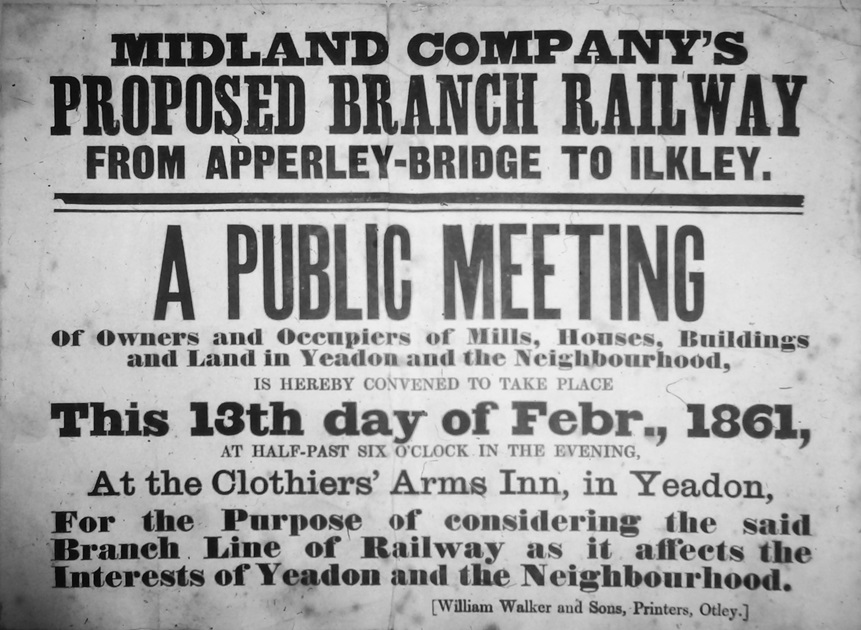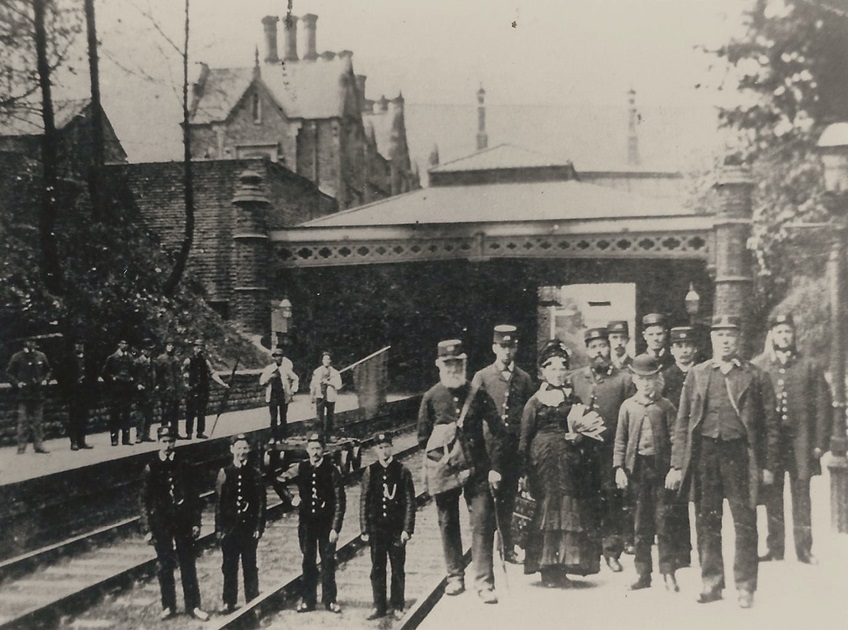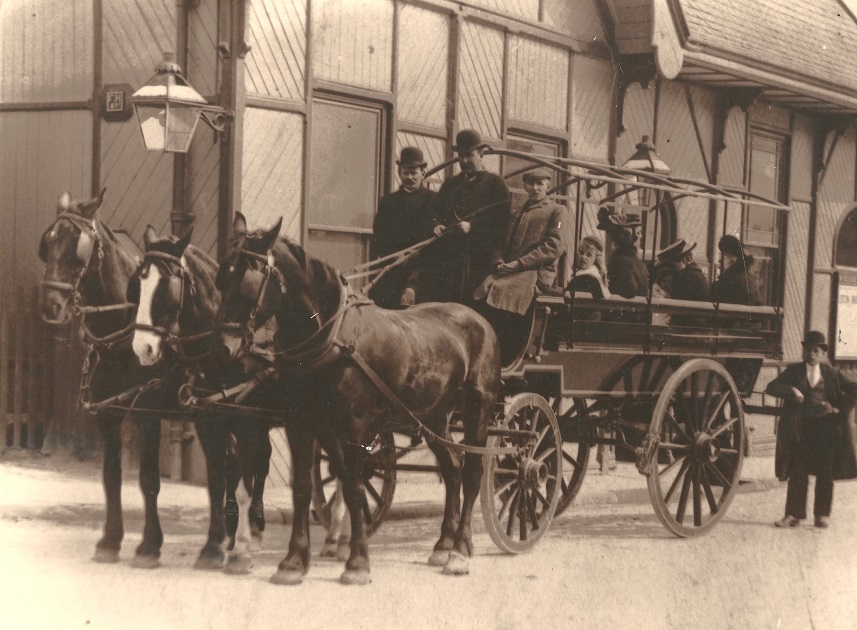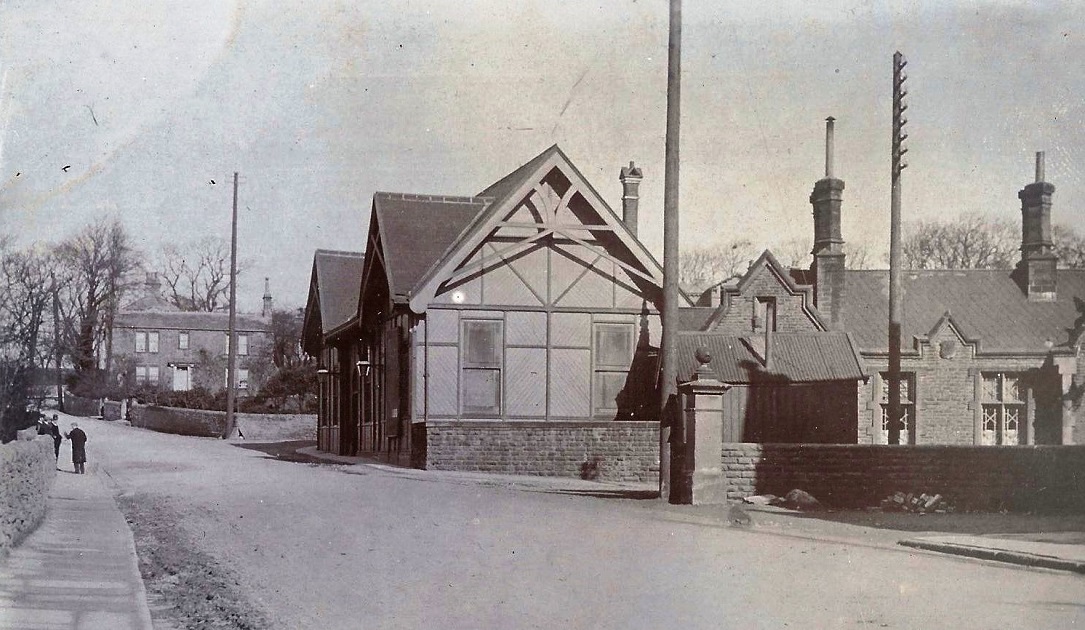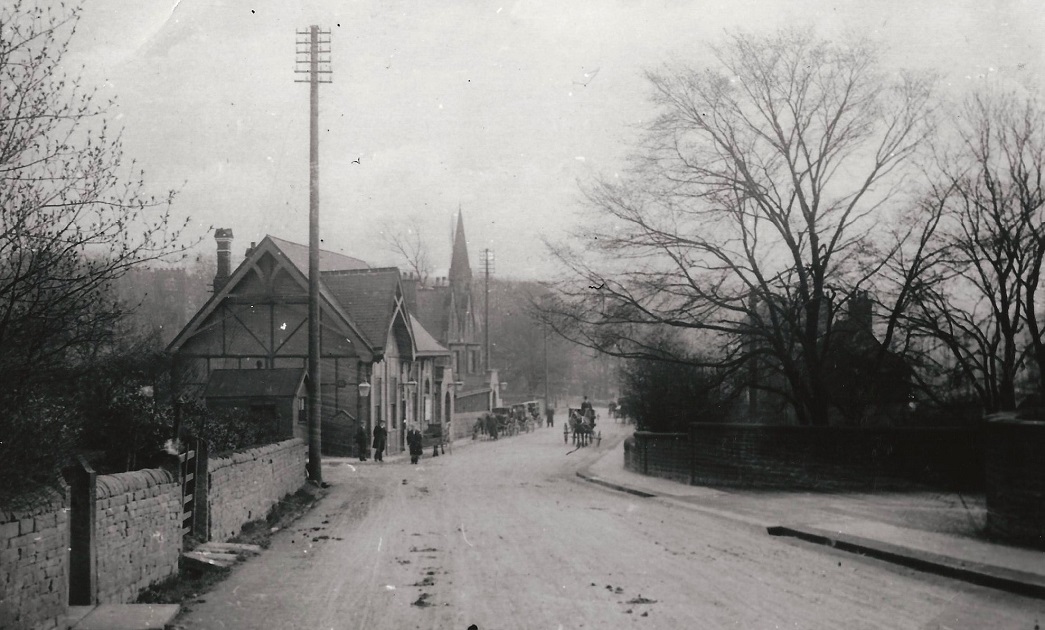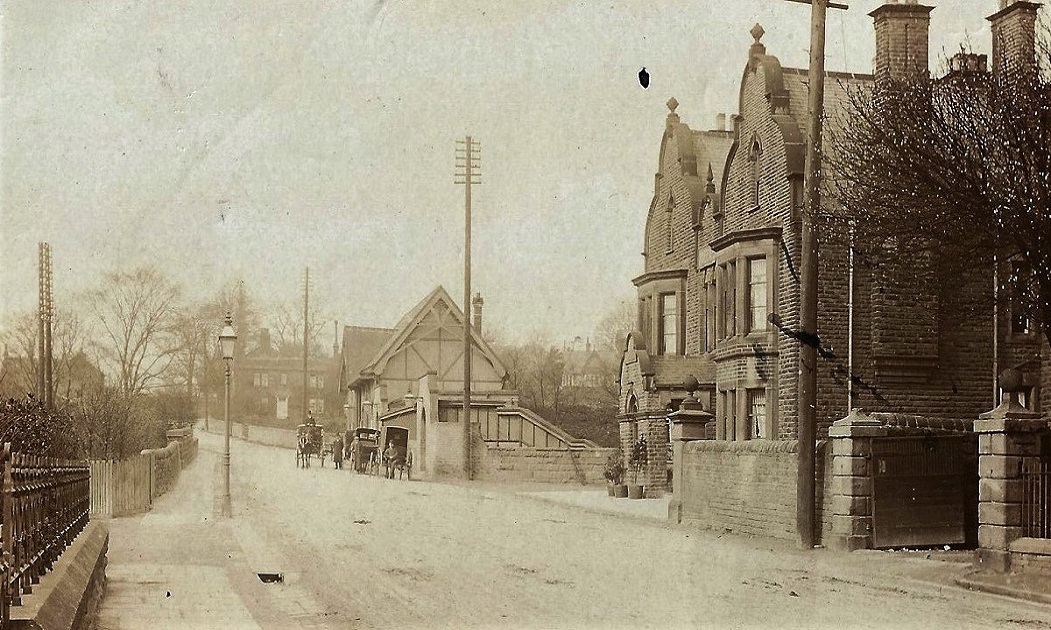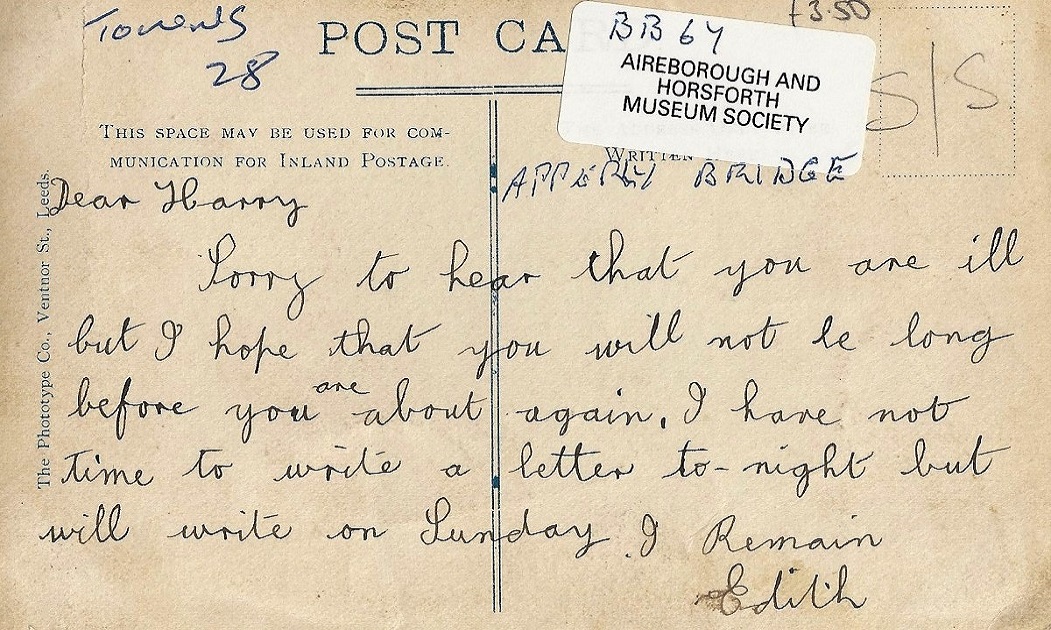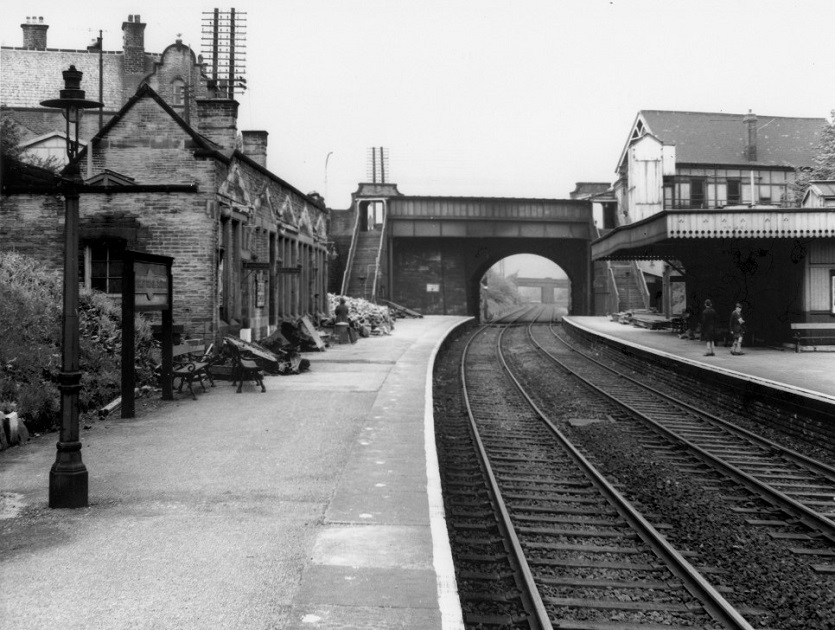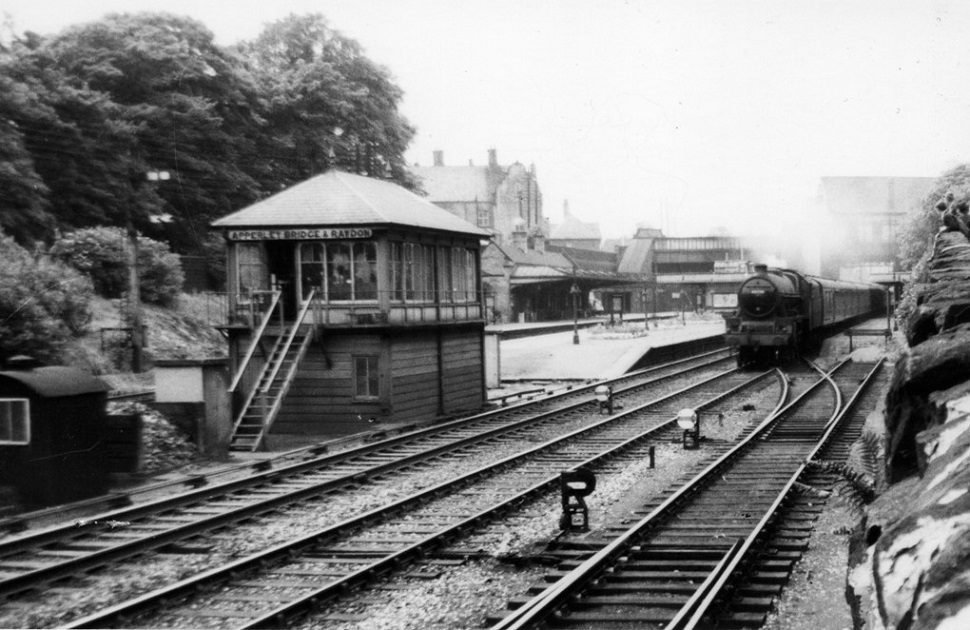| Title | Apperley Bridge Station |
| Date | 1861 |
| Location | Rawdon |
| Photo ID | X873 |
| Comment | See below … |
A Midland Company’s poster detailing a proposed branch railway public meeting to be held at the Clothier’s Arms Inn, Yeadon, on 13 Feb 1861.
Apperley Bridge Station – 1883
Staff at Apperley Bridge Station assembled for this early photograph.
The lady in the middle of the group on the right is selling newspapers.
Information on the reverse of the image indicates that her name was Mrs Ellen Thomas, great, great, grandmother of Dennis Smith.
Apperley Bridge Station – 1896
A horse drawn bus operated by Powell Midgeley of Yeadon, he had a stables and livery yard on Yeadon High Street, on what was the site of the Picture House (now The Aviator, September 2014).
The timed service took passengers to and from the station via Rawdon to Yeadon and vice versa, Mr Midgeley is the driver holding the reins with S Power on his left and George Priestley on the right.
Martin Bairstow added this information:
As far as I can tell, this is after enlargement of the station in 1901.
See A307.
Samuel Powell Midgley, cab proprietor of High St, Yeadon, placed a notice in the London Gazette of 27 October 1896. William Edward Midgley was no longer a partner in Midgley Brothers, the business to continue with Samuel Powell Midgley as sole proprietor.
Maybe this is where the date 1896 comes from.
Apperley Bridge Station – 1898
Apperley Bridge was opened as a temporary station in July 1846, on the Leeds to Bradford Line.
A year later the first of the permanent platforms was built partly covered by a roof. Woodhouse Grove School provided many passengers, the railway had crossed their land.
The station was lit by gas bought from the school about 1849.
The station fell foul of the Beeching axe, closing on 20th March 1965.
In 1999, Metro proposed to reopen the station, there has been much residential development in the area adding to road traffic congestion.
This, with a new station on the old Kirkstall Forge site were due to be completed by 2012.
This has not happened. (March 2013)
New information from Martin Bairstow a much regarded author of several railway books.
A307 This shows both the new wooden building, surmounting the still double track railway and the 1847 stone building which will have to be demolished to allow the land underneath to be excavated for the “fast” lines and additional platforms. The quadrupling was authorised by an Act of July 1898 and completed on 17 November 1901.
The new station building had to be done first. Logically, it would have come quickly after the passing of the Act, hence my suggestion of 1898 for the date of A307. I suppose it could have been a little earlier as this work in itself might not have needed Parliamentary powers. But there was no reason to do it except in anticipation of the quadrupling. I don`t think the date of 1896 attributed to C276 is correct or that it has any bearing on the date of A307.
The building in A307 is symmetrical with twin outward facing gables and entrance in the middle. It has been designed as though its function over the double track railway was permanent. I don’t think it possible for this to imply that it was done before quadrupling was thought of. Much more likely that they just used a standard design and/ or hadn't yet decided how it would dovetail into the enlarged station.
All the post 1901 photos show the nearer (south) outward gable to have disappeared. They show the upper half of the side gable identical to the 1898 view. The lower half has been pierced by the covered walkway. This and the additional entrance and staircase down to the new island platform have caused the very early demise of the outward gable. Hence the rather strange unbalanced appearance of the station from 1901 up to closure in 1965 and subsequent demolition.
All of which is hopefully leading towards reopening next year. Government finance was finally agreed in May. Per the West Yorks PTE website, work is to begin this month. After waiting 49 years, so far, I`ll believe it when I see it.
Regards, Martin Bairstow.
Apperley Bridge Station – 1905
Outside the station is a row of horse drawn cabs waiting to convey passengers to Yeadon or Greengates.
Behind the station is the spire of Woodhouse Grove School, Wesleyan Chapel, can be seen.
On the right is the entrance to the drive leading to Esholt Hall, which is about one and a half miles away.
New information from Martin Bairstow, who is a well known author of several railway books.
A309 shows the station after completion of the quadrupling in 1901.
Your date of 1905 may well be correct.
The main building is the same as in A307, but there is now a covered way leading to the additional platforms on the “fast” lines.
Apperley Bridge Station – Undated
On this photo postcard, carriages wait to transport rail passengers from the station, often to Rawdon or Yeadon where several carters offered this service.
Station Road is on the right between the station buildings and the Queens public house.
Apperley Bridge Station – Undated
On the reverse of the postcard is a message :
“Dear Harry, Sorry to hear that you are ill but I hope you will not be long before you are about again. I have no time to write a letter to-night but will write on Sunday. I Remain Edith”
Apperley Bridge Station – c1960s
Description is by Martin Bairstow the image donor:
“I always put “fast” and “slow” in inverted commas because on this line they had nothing to do with speed. If “fast” meant anything it was direct from Leeds to Bradford for which purpose “fast” lines passed over the “slow” between Armley and Kirkstall. The route from Leeds to Shipley was quadrupled in stages around the turn of the century and reduced back to double track in 1967. The surviving lines are “slow”, the original lines vary. In Apperley Bridge Station the “slow” were original. Across Apperley Viaduct and through the Thackley tunnel the “fast” were original so the surviving lines on that stretch are the additions of 1898 – 1901, not the originals of 1846.
Consolidated by Jack Brayshaw. 26 Apr 21.
Last updated: 24 December 2023 – Photo ID: X873. 29 September 2023 – Photo ID: H274, H275 & H276. 28 September 2022 – All Images.
